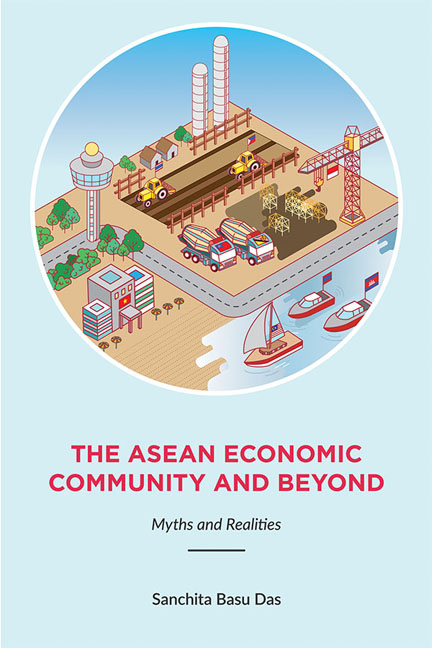Book contents
- Frontmatter
- Dedication
- Contents
- Foreword
- Acknowledgements
- Abbreviations
- 1 Introduction: The ASEAN Economic Community and Beyond
- I THE ASEAN ECONOMIC COMMUNITY (AEC)
- II BEYOND THE ASEAN ECONOMIC COMMUNITY
- 9 The Regional Comprehensive Economic Partnership: Going Beyond ASEAN+1 FTAs
- 10 Comparing ASEAN+1 FTAs for an Effective RCEP
- 11 Challenges in Negotiating the Regional Comprehensive Economic Partnership Agreement
- 12 The Next Decade in ASEAN-U.S. Economic Relations
- 13 RCEP and TPP: Comparisons and Concerns
- 14 The Trans-Pacific Partnership (TPP): Economic and Strategic Implications for the Asia-Pacific
- 15 The Trans-Pacific Partnership as a Tool to Contain China: Myth or Reality?
- 16 RCEP and TPP: Can They Converge into an FTAAP?
- 17 Is APEC's Relevance Fading?
- III AN ASEAN PERSPECTIVE OF REGIONAL CONNECTIVITY
- Appendix: Summary of the Trans-pacific Partnership Agreement
- Index
- About the Author
9 - The Regional Comprehensive Economic Partnership: Going Beyond ASEAN+1 FTAs
from II - BEYOND THE ASEAN ECONOMIC COMMUNITY
Published online by Cambridge University Press: 19 May 2017
- Frontmatter
- Dedication
- Contents
- Foreword
- Acknowledgements
- Abbreviations
- 1 Introduction: The ASEAN Economic Community and Beyond
- I THE ASEAN ECONOMIC COMMUNITY (AEC)
- II BEYOND THE ASEAN ECONOMIC COMMUNITY
- 9 The Regional Comprehensive Economic Partnership: Going Beyond ASEAN+1 FTAs
- 10 Comparing ASEAN+1 FTAs for an Effective RCEP
- 11 Challenges in Negotiating the Regional Comprehensive Economic Partnership Agreement
- 12 The Next Decade in ASEAN-U.S. Economic Relations
- 13 RCEP and TPP: Comparisons and Concerns
- 14 The Trans-Pacific Partnership (TPP): Economic and Strategic Implications for the Asia-Pacific
- 15 The Trans-Pacific Partnership as a Tool to Contain China: Myth or Reality?
- 16 RCEP and TPP: Can They Converge into an FTAAP?
- 17 Is APEC's Relevance Fading?
- III AN ASEAN PERSPECTIVE OF REGIONAL CONNECTIVITY
- Appendix: Summary of the Trans-pacific Partnership Agreement
- Index
- About the Author
Summary
The Regional Comprehensive Economic Partnership (RCEP) came into being in November 2011, with the objective of attaining a comprehensive and mutually beneficial economic partnership agreement that is likely to have deeper engagement and is expected to improve over the existing ASEAN FTAs with Dialogue Partners. The Agreement takes into account the East Asia Free Trade Agreement, based on the ASEAN+3 formula and favoured by China and the Comprehensive Economic Partnership in East Asia, based on the East Asia Summit and favoured by Japan. RCEP is expected to entrench ASEAN Centrality that assumes that ASEAN, instead of the bigger economies like those of China, Japan, the United States or India, should be the hub of developing a wider Asia-Pacific regional architecture.
However, to be an effective trade agreement, RCEP needs to be a business-friendly initiative, thereby aiming to maximize benefits and lower costs of businesses in the region. It should be WTO-consistent, comprehensive in coverage with WTO plus issues and should be open to new members, depending on the emerging production networks. It should focus on domestic structural reforms, which is a key factor for implementing the initiative later. RCEP, as a broader Asian trade agreement, involving China and India, is expected to address the issue of Non-tariff barriers, multiple Rules-of-Origin and may unleash the potential of trade in services. But much depends on how ASEAN drives its own integration effort of forming an ASEAN Economic Community (AEC) by 2015 and the years later.
INTRODUCTION
During the 21st ASEAN Summit in November 2012, Asia is going to see yet another regional arrangement come into being. This one will be called the Regional Comprehensive Economic Partnership (RCEP), the framework of which was endorsed by Leaders at the 19th ASEAN Summit in November 2011. The RCEP takes into account the East Asia Free Trade Agreement (EAFTA) and the Comprehensive Economic Partnership in East Asia (CEPEA) initiatives, with the difference that the RCEP is not working on a pre-determined membership. Instead, it is based on open accession which enables participation of any of the ASEAN FTA partners (China, Korea, Japan, India and Australia-New Zealand) at the outset or later when they are ready to join. The arrangement is also open to any other external economic partners.
- Type
- Chapter
- Information
- The ASEAN Economic Community and BeyondMyths and Realities, pp. 95 - 103Publisher: ISEAS–Yusof Ishak InstitutePrint publication year: 2015



